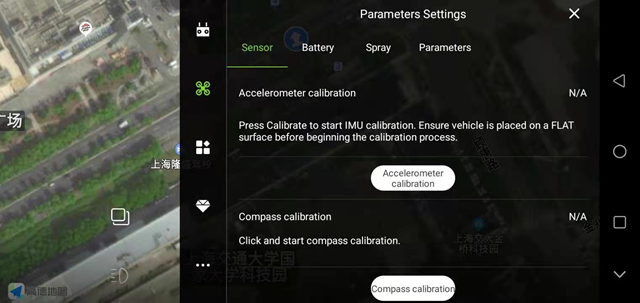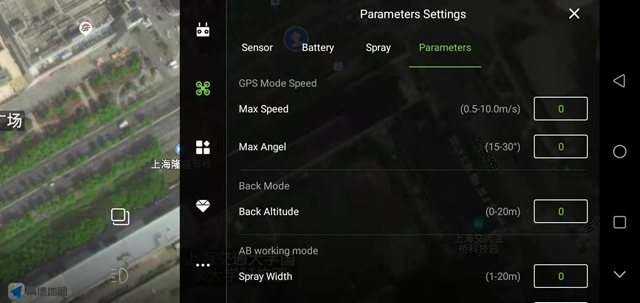Parameter setting interface
The parameter setting interface includes: sensor, battery setting, spraying setting, and flight parameters.

1. Sensor
The newly installed aircraft must be calibrated with accelerometer and magnetic compass.
Accelerometer calibration: Click the “Accelerometer Calibration” button, and the calibration will be completed after 3-5 seconds. If the vehicle body is placed at a large tilt angle or shaken during calibration, it needs to be recalibrated.
Magnetic compass calibration: When the flight controller is not unlocked, quickly turn the 5th channel flight mode switch back and forth (or click “magnetic compass calibration” on the APP) to enter the magnetic compass calibration on both sides. The yellow light is always on, and the horizontal calibration is entered. At this time, place the aircraft horizontally and rotate the axis clockwise in the direction of gravity until the green LED light is always on, and then enter the vertical calibration. At this time, the head is facing down and the axis of gravity rotates until the LED flashes alternately in red, green and yellow, and the calibration is completed.

2. Battery settings
Low voltage protection: When the aircraft is in flight, after the low voltage protection is triggered, it will perform protection actions, including: shutdown, return, hover, and hover landing; generally it will be set to hover.
Take the 12S battery as an example. Level 1 alarm voltage: 44.3V, level 2 alarm voltage: 43.6V.
If the actual voltage of the battery does not match the voltage displayed on the APP, enter the actual voltage value at the measured voltage and click Save to perform voltage calibration.

3. Spray setting
Discharge protection behavior: When the aircraft is in flight, after triggering the discontinuation protection, the protection behavior will be executed, including: shutdown, return, hover, and hover landing; generally it will be set to hover


Set the flow meter type: depending on the actual equipment installation, when using one flow meter, select a single flow meter; when using two flow meters, select a dual flow meter.

Type of level gauge: when using flow rate timer, select None; when using level timer, select switch level gauge;
Double water pump mode: When using two water pumps, turn on the “dual water pump mode” switch, then there will be no spraying before and after spraying in flight; when the switch of “dual water pump mode” is turned off, it will appear when spraying in flight The situation of two water pumps spraying together;
Automatic control of water pump in operation mode: After turning on the switch, the water pump will be automatically turned on during flight operation;
Flowmeter calibration: After clicking “Flowmeter Calibration”, follow the APP prompts to operate.
4. Flight parameters
Maximum flight speed: the maximum speed of the aircraft in manual flight. When the obstacle avoidance radar is installed, the maximum speed is recommended to be limited to 6m/s;
Maximum tilt angle: the maximum tilt of the aircraft during manual flight. When installing obstacle avoidance radar, it is recommended that the maximum speed be limited to 15 degrees;
Return altitude: the flight altitude of the aircraft when it returns home after the aircraft triggers the return home protection;

AB operation mode-line spacing: the distance between adjacent routes during AB operation;
AB operation mode-route speed: the flight speed of the aircraft during AB operation;
Route operation-route speed: the flight speed of the aircraft when performing fully autonomous operations;

Operation completion behavior: After completing the fully autonomous operation, the protection behavior triggered by the aircraft is generally set to hover;
U-turn on: When the switch is turned on, a U-turn will be executed when the aircraft is turning; when it is off, a right-angle turn will be executed when the aircraft is turning;

Heading mode: manually control the heading, automatically align the course, and point to the next target.
Manual heading control: During AB operations or fully autonomous operations, the nose direction of the aircraft needs to be controlled by the remote control;
Automatic alignment: during AB operation or fully autonomous operation, the flight controller will automatically align the flight alignment, and the nose does not rotate;
Point to the next target: During AB operation or fully autonomous operation, the nose is always pointed to the next target point, even when turning.

When returning home, the direction of the nose is unchanged, the nose is toward the home point, and the tail is toward the home point.
No change: When the aircraft returns home, the nose direction is toward the direction of the previous flight;
Head toward home point: When the plane returns home, the direction of the nose toward home point;
The tail of the aircraft faces the home point: When the aircraft returns home, the tail direction of the aircraft faces the direction of the home point;
